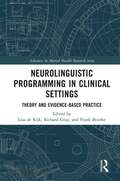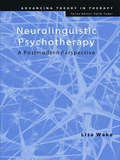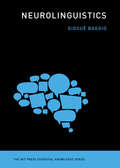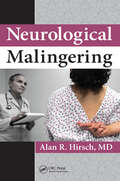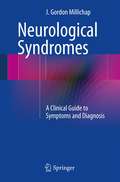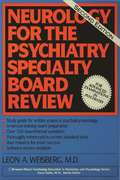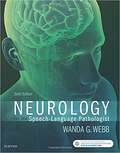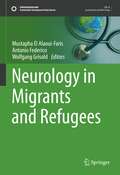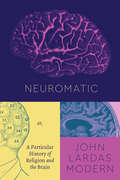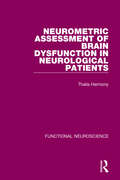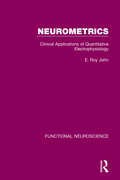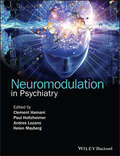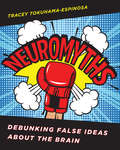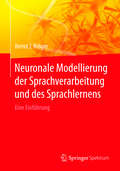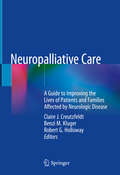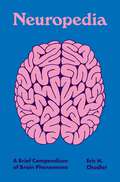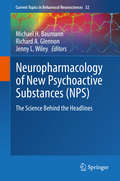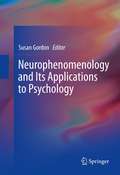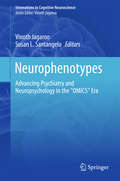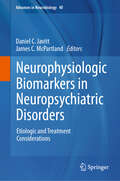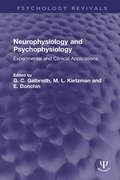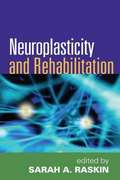- Table View
- List View
Neurolinguistic Programming in Clinical Settings: Theory and evidence- based practice (Advances in Mental Health Research)
by Lisa De RijkNeurolinguistic Programming in Clinical Settings provides a theoretical framework for the clinical applications of Neurolinguistic Programming (NLP) protocols in mental health. It offers evidence-based models for a range of conditions; including PTSD, anxiety and depression, grief, phobias and binge-eating. Providing a follow up to the 2014 book The Clinical Effectiveness of Neurolinguistic Programming, this book updates the existing research evidence for NLP interventions with mental health clinical conditions. It includes further evidence for its use with somatoform disorders, anxiety and depression, and as a general psychotherapy modality. The book outlines up-to-date evidence from clinical trials that demonstrate the success rate of NLP with PTSD populations and discusses how ongoing randomised clinical trials at Kings College London are demonstrating the clinical effectiveness of NLP protocols and are becoming more widely accepted by mainstream mental health care. Written by a team of internationally academically informed clinicians and researchers, the book will be key reading for academics, researchers and post-graduate students in the field of mental health research, psychotherapy and counselling. It will also be of interest to clinicians and mental health professionals interested in NLP as a therapeutic modality.
Neurolinguistic Psychotherapy: A Postmodern Perspective (Advancing Theory in Therapy)
by Lisa WakeNeurolinguistic Psychotherapy offers a unique and exciting postmodern perspective on an advancing model of therapy. It places neurolinguistic psychotherapy in context and considers the history of NLP and its relationship to psychotherapy. Presented as an effective model for facilitating neurological change through the therapeutic relationship, this book challenges therapists to incorporate a psychodynamic approach within their work. In addition the book also presents: A model of the developing personality and the relationship to attachment theory and emerging theories of neuroscience. A discussion of the linguistic components of NLP and the effectiveness of utilising the language patterns offered by NLP. A challenge to neurolinguistic psychotherapists – asking them to consider the benefits of including relational approaches to therapy above that offered by a programmatic model of change. This book will be of great interest to all psychotherapeutic practitioners and trainers, students and academics.
Neurolinguistics (The MIT Press Essential Knowledge series)
by Giosue BaggioAn accessible introduction to the study of language in the brain, covering language processing, language acquisition, literacy, and language disorders.Neurolinguistics, the study of language in the brain, describes the anatomical structures (networks of neurons in the brain) and physiological processes (ways for these networks to be active) that allow humans to learn and use one or more languages. It draws on neuroscience, linguistics—particularly theoretical linguistics—and other disciplines. In this volume in the MIT Press Essential Knowledge series, Giosuè Baggio offers an accessible introduction to the fundamentals of neurolinguistics, covering language processing, language acquisition, literacy, and speech and language disorders. Baggio first surveys the evolution of the field, describing discoveries by Paul Broca, Carl Wernicke, Noam Chomsky, and others. He discusses mapping language in &“brain time&” and &“brain space&” and the constraints of neurolinguistic models. Considering language acquisition, he explains that a child is never a &“blank slate&”: infants and young children are only able to acquire specific aspects of language in specific stages of cognitive development. He addresses the neural consequences of bilingualism; literacy, discussing how forms of visual language in the brain differ from forms of auditory language; aphasia and the need to understand language disorders in behavioral, functional, and neuroanatomical terms; neurogenetics of language; and the neuroethology of language, tracing the origins of the neural and behavioral building blocks of human linguistic communication to the evolution of avian, mammalian, and primate brains.
Neurological Malingering
by Alan R. HirschWritten from the viewpoint of the practicing clinician, this text is an indispensable addition to the library of anyone who is in the practice of medicine, osteopathy, or chiropractic, as well as for the judge, lawyer, or social worker who may interact with those presenting with the possibility of malingering. Other topics discussed include Waddell’s Signs, the Pinocchio Phenomenon, the Othello Error, the Menace Reflex, the Reliable Digit Span, Lombard’s Test, the Babinski Sign of the Eyebrow, the Hummel Double Conversation Test, the Swinging Story Test, the Judd-Persaud Test, the Teal Test, the Chimani-Moos Test, the Occlusion Effect, the Drop Arm Test, the Drop Leg Test, the Honest Palm Sign, the Elbow-Flex-Ex Sign, Beevor's Sign, Schober's Test, the Babinski Trunk-Thigh Test, and the Barré Test. Advance praise for Neurological Malingering "Dr. Hirsch’s book is long overdue and covers a critical topic of concern to all medical practitioners. This comprehensive treatise is a must for all physicians, psychologists, and others who work with patients who have incentive to gain from the system. Multiple topics related to malingering are presented in 16 straightforward chapters never before compiled in a single volume. I recommend this book highly to anyone concerned about malingering and its impact on the medical system." - Richard L. Doty, PhD, FAAN, Professor and Director, Smell and Taste Center, Perelman School of Medicine, University of Pennsylvania "Malingering affects not only the malingerers, but the persons and institutions around them as well. As a lay person, the readings have certainly made me considerably more sensitive to suspect behavior. And where knowledge of the underlying condition can affect relationships or transactions one is associated with, it is certainly useful to not only recognize its existence, but also to put it within the context of the challenges that it presents to those relationships or transactions. I count the time spent reading this most comprehensive work as well spent. I would further recommend it to others whose interests, decisions and/or professional pursuits could very well be affected by malingering, whether the behavior is or is not purposeful." - Judge Stephen A. Schiller (Retired), Circuit Court of Cook County, Illinois
Neurological Syndromes: A Clinical Guide to Symptoms and Diagnosis
by J. Gordon MillichapNeurological Syndromes: A Clinical Guide to Symptoms and Diagnosis offers a concise, invaluable resource for understanding how a group of neurologic symptoms or signs collectively characterize a disease or disorder. Intended as a quick reference guide to the better known and some less familiar syndromes of neurological interest and developed by a renowned pediatric neurologist with more than 40 years experience in treating children, adolescents, and young adults, this handy title provides a definition of each syndrome that includes diagnostic characteristics and abnormalities, a differential diagnosis, genetic considerations, and a short list of references. To those readers who can recall the name of a syndrome, the alphabetical presentation should facilitate a review of the major diagnostic characteristics. The original reference is provided for historical interest, and review articles are included to show recent advances in etiology and treatment. The index is arranged in alphabetical order of the named syndromes and also according to the involvement of various organs in addition to the nervous system. A unique contribution to the literature, Neurological Syndromes: A Clinical Guide to Symptoms and Diagnosis will be of great interest to the wide variety of clinicians treating patients with neurologic disease.
Neurology For The Psychiatry Specialist Board
by Leon A. WeisbergThis new edition of Neurology for the Psychiatry Specialty Board Review, provides an accurate and comprehensive review of the most frequently encountered topics in the field of clinical neurology and neuroscience.The second edition features all new questions and provides answers and explanations that are referenced to standard textbooks. It offers a varied testing format, including clinical vignettes and matching, true-false, and multiple choice questions. The author consulted with medical students and faculty on incorporating new material. Neurology for the Psychiatry Specialty Board Review, Second Edition is a thorough and indispensable tool for preparing for the board certification or re-certification examination in psychiatry or neurology, for in-service training examinations, or simply as a test of the reader's knowledge of the field.
Neurology for the Speech-Language Pathologist (Sixth Edition)
by Wanda G. WebbThe concise, easy-to-understand Neurology for the Speech-Language Pathologist, 6th Edition provides students and clinicians with a practical guide for the study and understanding of neurology in speech-language pathology (SLP). Correlated with clinical syndromes and diseases seen in SLP, it gives you a solid understanding of the nervous system, including: development of the nervous system, organization of the brain, protective mechanisms, descending motor and ascending sensory pathways, and cranial nerves. New content, case studies, and a strong clinical focus make this new edition essential as you move into practice.
Neurology in Migrants and Refugees (Sustainable Development Goals Series)
by Wolfgang Grisold Mustapha El Alaoui-Faris Antonio FedericoThis book is the result of reflections and work of the Specialty group on neurology in migrants of the World Federation of Neurology. The volume provides a synthesis of migrants’ health in relation to the sustainable development goals and the 2030 agenda, and an up-to-date overview on neurological diseases among migrants, refugees and ethnic minorities.The book is composed of both general chapters dealing with the history of migration, the relationship between climate change and migration flows, the migration and neurosciences research and the barriers to migrant’s health. Other chapters deal with the migrants' particularities of the common neurological diseases such as cerebrovascular diseases, epilepsy, dementia, movement disorders, multiple sclerosis, headache, functional and mental disorders. In addition, also neurological manifestation of COVID-19 in ethnic minorities and palliative care in migrants are discussed.Neurology in Migrants and Refugees will be useful to neurologists worldwide who can find appropriate knowledge for diagnosis and treatment when facing migrants with neurological disorders which are sometimes difficult to assess in the absence of clinical experience with the migrant population. It will also be very useful for international organizations, policymakers and non-governmental organizations working in the field of health and migration.This book will certainly find an indispensable place in neurological departments libraries and will constitute a basic textbook for teaching neurology taking into account ethnicity, culture and health inequalities in the care of neurological disorders.
Neuromatic: Or, A Particular History of Religion and the Brain (Class 200: New Studies in Religion)
by John Lardas ModernJohn Modern offers a powerful and original critique of neurology’s pivotal role in religious history. In Neuromatic, religious studies scholar John Lardas Modern offers a sprawling examination of the history of the cognitive revolution and current attempts to locate all that is human in the brain, including spirituality itself. Neuromatic is a wildly original take on the entangled histories of science and religion that lie behind our brain-laden present: from eighteenth-century revivals to the origins of neurology and mystic visions of mental piety in the nineteenth century; from cyberneticians, Scientologists, and parapsychologists in the twentieth century to contemporary claims to have discovered the neural correlates of religion. What Modern reveals via this grand tour is that our ostensibly secular turn to the brain is bound up at every turn with the religion it discounts, ignores, or actively dismisses. In foregrounding the myths, ritual schemes, and cosmic concerns that have accompanied idealizations of neural networks and inquiries into their structure, Neuromatic takes the reader on a dazzling and disturbing ride through the history of our strange subservience to the brain.
Neuromatic: Or, A Particular History of Religion and the Brain (Class 200: New Studies in Religion)
by John Lardas ModernJohn Modern offers a powerful and original critique of neurology’s pivotal role in religious history. In Neuromatic, religious studies scholar John Lardas Modern offers a sprawling examination of the history of the cognitive revolution and current attempts to locate all that is human in the brain, including spirituality itself. Neuromatic is a wildly original take on the entangled histories of science and religion that lie behind our brain-laden present: from eighteenth-century revivals to the origins of neurology and mystic visions of mental piety in the nineteenth century; from cyberneticians, Scientologists, and parapsychologists in the twentieth century to contemporary claims to have discovered the neural correlates of religion. What Modern reveals via this grand tour is that our ostensibly secular turn to the brain is bound up at every turn with the religion it discounts, ignores, or actively dismisses. In foregrounding the myths, ritual schemes, and cosmic concerns that have accompanied idealizations of neural networks and inquiries into their structure, Neuromatic takes the reader on a dazzling and disturbing ride through the history of our strange subservience to the brain.
Neuromatic: Or, A Particular History of Religion and the Brain (Class 200: New Studies in Religion)
by John Lardas ModernJohn Modern offers a powerful and original critique of neurology’s pivotal role in religious history. In Neuromatic, religious studies scholar John Lardas Modern offers a sprawling examination of the history of the cognitive revolution and current attempts to locate all that is human in the brain, including spirituality itself. Neuromatic is a wildly original take on the entangled histories of science and religion that lie behind our brain-laden present: from eighteenth-century revivals to the origins of neurology and mystic visions of mental piety in the nineteenth century; from cyberneticians, Scientologists, and parapsychologists in the twentieth century to contemporary claims to have discovered the neural correlates of religion. What Modern reveals via this grand tour is that our ostensibly secular turn to the brain is bound up at every turn with the religion it discounts, ignores, or actively dismisses. In foregrounding the myths, ritual schemes, and cosmic concerns that have accompanied idealizations of neural networks and inquiries into their structure, Neuromatic takes the reader on a dazzling and disturbing ride through the history of our strange subservience to the brain.
Neurometric Assessment of Brain Dysfunction in Neurological Patients (Functional Neuroscience)
by Thalía HarmonyOriginally published in 1984, the aim of this book was to interest clinical neuroscientists in the application of neurometrics to the evaluation of brain dysfunction in neurological patients. This methodology was hoped to produce substantial improvement in the neurological medical care of the general population at the time. In the previous 15 years, as a result of the development of minicomputers and their application to the quantitative analysis of electrophysiological phenomena, there had been a great expansion of knowledge about the electrical activity of the brain. This activity yielded a great variety of information about brain functions. Neurometrics is a methodology, based on quantitative measurements of the brain electrical activity, for evaluating anatomical integrity, developmental maturation, and the mediation of sensory, perceptual, and cognitive processes. This book focuses on practical clinical applications and the theoretical and experimental formulations on which these are based.
Neurometrics: Clinical Applications of Quantitative Electrophysiology (Functional Neuroscience)
by E. Roy JohnOriginally published in 1977, this volume attempts to show how the existing state of knowledge and technique in neuroscience can be effectively applied to a variety of practical clinical problems that at the time were dealt with less than adequately. Traditionally, clinical electroencephalography had been one of the major techniques by which our knowledge of neuroscience had been brought to bear upon these problems. The utility of this technique had been sharply limited and constrained by reliance upon qualitative interpretation of electrophysiological observations. In contrast, the approach proposed here is based upon quantitative measurements of salient features extracted from electrophysiological data which reflect various aspects of brain function related to sensory, perceptual and cognitive processes as well as to the structural and functional integrity of different neuroanatomical systems. The Editors call this quantitative approach "neurometrics".
Neuromodulation in Psychiatry
by Clement Hamani Helen Mayberg Paul Holtzheimer Andres M LozanoEdited by an expert multidisciplinary team, Neuromodulation in Psychiatry is the first reference guide to address both invasive and non-invasive neuromodulation strategies used in psychiatry. Covers basic principles, technical aspects, clinical applications and ethical considerations Presents up-to-date evidence in comprehensive summaries suitable for all levels of experience Each technique is clearly explained along with its implications for real-world clinical practice Allows psychiatrists to make informed decisions regarding neuromodulation for their patients
Neuromyths: Learning About Teaching By Debunking False Ideas About The Brain
by Tracey Tokuhama-EspinosaA guide to the science behind the art of teaching. Not every teaching method touted as "brain-friendly" is supported by research findings—and misconceptions about the brain have the capacity to harm rather than help. In her new book, Tracey Tokuhama-Espinosa untangles scientific fact from pedagogical fiction, debunking dozens of widely held beliefs about the brain that have made their way into the education literature. In ten central chapters on topics ranging from brain structure to classroom environments, the text traces the origins of common neuromyths—from categorizing individuals as "right-brained" or "left-brained" to prevailing beliefs about multitasking or the effects of video games—and corrects the record with the most current state of knowledge. Rather than offering pat strategies, Tokuhama-Espinosa challenges teachers curious about the brain to become learning scientists, and supplies the tools needed to evaluate research and put it to use in the classroom.
Neuronal Dynamics
by Wulfram Gerstner Werner M. Kistler Richard Naud Liam PaninskiWhat happens in our brain when we make a decision? What triggers a neuron to send out a signal? What is the neural code? This textbook for advanced undergraduate and beginning graduate students provides a thorough and up-to-date introduction to the fields of computational and theoretical neuroscience. It covers classical topics, including the Hodgkin-Huxley equations and Hopfield model, as well as modern developments in the field such as Generalized Linear Models and decision theory. Concepts are introduced using clear step-by-step explanations suitable for readers with only a basic knowledge of differential equations and probabilities, and are richly illustrated by figures and worked-out examples. End-of-chapter summaries and classroom-tested exercises make the book ideal for courses or for self-study. The authors also give pointers to the literature and an extensive bibliography, which will prove invaluable to readers interested in further study.
Neuronale Modellierung der Sprachverarbeitung und des Sprachlernens: Eine Einführung
by Bernd J. KrögerDieses Buch erläutert die Thematik der Produktion und Wahrnehmung gesprochener Sprache aus neurowissenschaftlicher Sicht. Nach der Darstellung der Grundlagen der Sprachverarbeitung und des Spracherwerbs wird dem Leser ein neurobiologisch basiertes und computerimplementiertes neuronales Simulationsmodell vorgestellt. Diese Einführung in die quantitative und computerimplementierbare Modellierung der Sprachverarbeitung und des Sprachlernens basiert auf einem naturwissenschaftlich orientierten Ansatz zur Beschreibung gesprochener Sprache. Dennoch wird weitgehend auf mathematische Beschreibungen verzichtet.Das Buch spricht Studierende und Wissenschaftler der Bereiche Neurowissenschaften, Informatik, Medizin, Psychologie und Linguistik an, die sich in das Gebiet der Sprachverarbeitung und des Spracherwerbs aus neurowissenschaftlicher Sicht einarbeiten möchten. Es richtet sich aber auch an Anwender, die sich mit der Entwicklung von Software zur Sprachverarbeitung befassen.
Neuropalliative Care: A Guide To Improving The Lives Of Patients And Families Affected By Neurologic Disease
by Claire J. Creutzfeldt Benzi M. Kluger Robert G. HollowayThis comprehensive guide thoroughly covers all aspects of neuropalliative care, from symptom-specific considerations, to improving communication between clinicians, patients and families. Neuropalliative Care: A Guide to Improving the Lives of Patients and Families Affected by Neurologic Disease addresses clinical considerations for diseases such as dementia, multiple sclerosis, and severe acute brain injury, as well discussing the other challenges facing palliative care patients that are not currently sufficiently met under current models of care. This includes methods of effective communication, supporting the caregiver, how to make difficult treatment decisions in the face of uncertainty, managing grief, guilt and anger, and treating the pain itself. Written by leaders in the field of neuropalliative care, this book is an exceptional, well-rounded resource of neuropalliative care, serving as a reference for all clinicians caring for patients with neurological disease and their families: neurologists and palliative care specialists, physicians, nurses, chaplains, social workers, as well as trainees in these areas.
Neuropedia: A Brief Compendium of Brain Phenomena (Pedia Books #12)
by Eric H. ChudlerA fun and fact-filled A–Z treasury for anyone with a head on their shouldersNeuropedia journeys into the mysteries and marvels of the three pounds of tissue between your ears—the brain. Eric Chudler takes you on a breathtaking tour of the nervous system with dozens of entries that explore the structure and function of the brain and cover topics such as the spinal cord and nerve cells, the methods of neuroscientific research, and the visionary scientists who have dedicated their lives to understanding what makes each of us who we are.The brain has fascinated and puzzled researchers, physicians, and philosophers for thousands of years and captivated us with each new discovery. This compendium of neuroscientific wonders is brimming with facts and insights, helping us to make sense of our current understanding of the nervous system while identifying the frontiers in our knowledge that remain unexplored. Chudler guides readers through a variety of rare and common neurological disorders such as alien hand disorder, Capgras syndrome, Alzheimer’s disease, Parkinson’s disease, and stroke, and discusses the latest brain-imaging methods used to diagnose them. He discusses neurochemicals, neurotoxins, and lifesaving drugs, and offers bold perspectives on human consciousness that enable us to better appreciate our place in nature.With marvelous illustrations by Kelly Chudler, Neuropedia is an informative and entertaining trip into the inner world of the brain.
Neuropharmacology of New Psychoactive Substances: The Science Behind the Headlines (Current Topics in Behavioral Neurosciences #32)
by Richard A. Glennon Michael H. Baumann Jenny L. WileyDesigner drugs, or new psychoactive substances (NPS), are synthetic chemicals that mimic the effects of classic drugs of abuse. There has been an alarming worldwide increase in the abuse of NPS in recent years. NPS are cheap, easy to obtain, and often legally available. In this volume, leading experts summarize the latest studies regarding the molecular mechanisms of action, behavioral effects, and adverse consequences of popular NPS. Specific chapters clarify the differences between various types of NPS, namely: stimulants, cannabinoids and hallucinogens. Thus, this volume broadens our understanding of NPS and provides insight into the rapidly evolving “new drug” phenomenon.
Neurophenomenology and Its Applications to Psychology
by Susan GordonThis book explores the meaning and import of neurophenomenology and the philosophy of enactive or embodied cognition for psychology. It introduces the psychologist to an experiential, non-reductive, holistic, theoretical, and practical framework that integrates the approaches of natural and human science to consciousness. In integrating phenomenology with cognitive science, neurophenomenology provides a bridge between the natural and human sciences that opens an interdisciplinary dialogue on the nature of awareness, the ontological primacy of experience, the perception of the observer, and the mind-brain relationship, which will shape the future of psychological theory, research, and practice.
Neurophenotypes
by Vinoth Jagaroo Susan L. SantangeloThis expansive text applies the latest knowledge of neural and cognitive biomarkers to the contemporary bioinformatics and "omics" landscape, and to neuropsychology and psychiatric research and practice. Focusing on neurophenotypes and endophenotypes, it updates concepts of neurocognitive and behavioral functioning, normal and disordered processes and structures, and their myriad relationships within the larger context of the nervous system. Specialized chapters delve into neural and cognitive gray areas that may be classified as neurophenotypes or cognitive endophenotypes, including face perception, reward deprivation, EEG data, and fear conditioning. These advances signal a new accuracy in neuroscience, from a more precise fit between data, tools, and models to more effective diagnosis, treatment, and policy. Among the topics covered: #65533; Brain and cognition in the "omics" era. #65533; Appraising circuit-centered neurophenotypes. #65533; Cognitive phenotypes and endophenotypes: concepts and criteria. #65533; The strategy and utility of the endophenotype approach to neurobehavioral function. #65533; Neural markers of errors as endophenotypes in neuropsychiatric disorders #65533; Implications for neuropsychology and psychiatry. Neurophenotypes and endophenotypes are critical discoveries in a developing field, and the analysis in Phenotypes spotlights their utility to neuropsychologists, neurologists, psychiatrists, and cognitive neuroscientists. This clarion work prepares research and clinical professionals for the world of technology- and science-based paradigms to come.
Neurophysiologic Biomarkers in Neuropsychiatric Disorders: Etiologic and Treatment Considerations (Advances in Neurobiology #40)
by Daniel C. Javitt James C. McPartlandThis book reviews neurophysiological biomarkers in neuropsychiatric disorders from the viewpoint of the 21st Century Cures Act, which encourages the use of biomarkers for a variety of purposes during drug development. It covers both traditional etiologic uses of biomarkers and the more recent Biomarkers, EndpointS, and other Tools (BEST) classification scheme used by the FDA, which permits biomarkers for purposes of susceptibility, diagnosis, monitoring, prognosis, pharmacodynamics/response, and safety. The first section of the book describes potential uses of neurophysiologic biomarkers. Subsequent sections focus on a wide range of conditions, including schizophrenia, autism spectrum disorder, Parkinson’s disease, and depression, as well as cross-diagnostic and translational uses, including monkey and rodent analogs. The purpose of the book is to help clinicians understand how neurophysiological biomarkers may be used to understand and manage clinical conditions; to help researchers to understand how biomarkers may be used translationally to test specific theories; and to help pharma investigators to understand how biomarkers can be used to accelerate treatment development.
Neurophysiology and Psychophysiology: Experimental and Clinical Applications (Psychology Revivals)
by G. C. Galbraith M. L. Kietzman E. DonchinOriginally published in 1988, in several respects this book is a tribute to the outstanding career of the late Donald B. Lindsley (1907-2003) who, over a span of more than 55 years, had contributed greatly to the development of research in the fields of neurophysiology, psychophysiology, and experimental psychology. The impetus for the book was a conference held at UCLA to honor Professor Lindsley for his numerous and significant contributions to psychology. The chapters of this book have been written by Professor Lindsley’s colleagues and co-workers, and by former students and postdoctoral fellows. The introductory chapter, written by Lindsley himself, tells of 2000 years of "pondering". The chapter is a discussion of the lengthy history of neurophysiology, psychophysiology, and behaviour. Many of the topics mentioned in this chapter are subsequently presented in the book as reports of ongoing research in the field.
Neuroplasticity and Rehabilitation
by Sarah RaskinBrain plasticity is the focus of a growing body of research with significant implications for neurorehabilitation. This state-of-the-art volume explores ways in which brain-injured individuals may be helped not only to compensate for their loss of cognitive abilities, but also possibly to restore those abilities. Expert contributors examine the extent to which damaged cortical regions can actually recover and resume previous functions, as well as how intact regions are recruited to take on tasks once mediated by the damaged region. Evidence-based rehabilitation approaches are reviewed for a range of impairments and clinical populations, including both children and adults.
